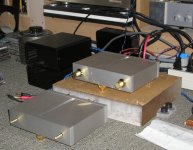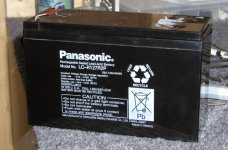So I tried OPA549 chip today. Same chassiss as other amps, the only difference Cardas copper posts instead of silver Rhodium plated. Inside wiring solid silver instead of silver plated stranded copper like other amps. Everything else the same. Nobel pots, 1W Rikken 10K resistor and Vishay S102 200k feedback resistor.
The OPA549 was less dramatic comparing to LM3875, less "flesh and blood" and less "technicolor" if you know what I mean. Sounded a bit lifeless and flat. I don't know if it's because of those minor changes or it's the chip, but to tell the truth it didn't really impress me on a first try. It sounded proper and everything was OK, it's just didn't seem to be special in any department, I think slightly more bass thou.
I had to use variac to lower the voltage on my usual supply and I noticed that with variac the amps sounded slightly better, more depth and maybe air. I also noticed that LM3875 sounded the best when the voltage was more than 18V on transformer and less than 25V. Probably something like 21-22 V AC on transformer might be a good choice.
The OPA549 was less dramatic comparing to LM3875, less "flesh and blood" and less "technicolor" if you know what I mean. Sounded a bit lifeless and flat. I don't know if it's because of those minor changes or it's the chip, but to tell the truth it didn't really impress me on a first try. It sounded proper and everything was OK, it's just didn't seem to be special in any department, I think slightly more bass thou.
I had to use variac to lower the voltage on my usual supply and I noticed that with variac the amps sounded slightly better, more depth and maybe air. I also noticed that LM3875 sounded the best when the voltage was more than 18V on transformer and less than 25V. Probably something like 21-22 V AC on transformer might be a good choice.
Peter Daniel said:The OPA549 was less dramatic comparing to LM3875, less "flesh and blood" and less "technicolor" if you know what I mean. Sounded a bit lifeless and flat. I don't know if it's because of those minor changes or it's the chip, but to tell the truth it didn't really impress me on a first try. It sounded proper and everything was OK, it's just didn't seem to be special in any department, I think slightly more bass thou..
Curious, virtually the opposite of my results, apart from the same increase in bass

I used standard quality parts for all my GCs, I wonder if this shows the OPA is a better basic design, yet the LMs need better component selection to sing?
So I tried OPA549 chip today...... The OPA549 was less dramatic comparing to LM3875, less "flesh and blood" and less "technicolor" if you know what I mean. Sounded a bit lifeless and flat.
I thought that these chip amps were meant to need quite a bit of burning in. If that's so, isn't it a bit unfair to judge the OPA549 so quickly?
Sparhawk said:
The amp can swing +/- 21V, so with a 4 ohm load, the current is:
21V / 4 ohm = 5.25A
The peak power is then:
21V x 5.25A = 110.25W
When the amp is fed a sine wave, the RMS output power is going to be:
110.25 x 0.707 = 77.95W
Hi,
sorry, but your peak power is with peak current and peak voltage. Rms power is smaller for one more factor 0.707.
Or P=Veff*Veff/Z=ca 15*15/4=55Wrms or Ieff*Ieff*Z,

Regards
moamps said:
Hi,
sorry, but your peak power is with peak current and peak voltage. Rms power is smaller for one more factor 0.707.
Or P=Veff*Veff/Z=ca 15*15/4=55Wrms or Ieff*Ieff*Z,
Regards
D'oh!

You're right, of course. The RMS power should be 0.5 x the peak power, not 0.707. So, 55W instead of 78.
Peter Daniel said:After recent comments on battery power, I couldn't wait any longer and decided to try them as well. I'll be using 4 or 6 of those. Any recommendations on a charging supply? I don't know much about that battery stuff.
I use a <a href="http://www.patcoelectronics.com/">Patco</a> InteliTender 300. It's a dual 12 volt charger (with floating grounds so you can connect it however you want) and is based on the TI power management chipsets that Synapse mentioned previously.
se
Nuuk said:
I thought that these chip amps were meant to need quite a bit of burning in. If that's so, isn't it a bit unfair to judge the OPA549 so quickly?
Maybe you were right. It sounds better today. One thing that I miss comparing to LM is a bit of extra air around vocals. I also hear some midrange flattening. Will see how it goes. Don't get me wrong it's pretty good sounding, it's just that I'm not as impressed as I expected.
Maybe you were right. It sounds better today.
I've done the same thing so many times myself! I'm sure we get to like a certain 'sound' and it takes a little time to adjust our hearing (or expectations).
Also, there's little doubt in my mind that even a single component change involving a resoldered joint takes at least 30 minutes or more to 'settle down'.
One thing that I miss comparing to LM is a bit of extra air around vocals. I also hear some midrange flattening.
Do you have them set up as well as your LM3675's? Just think how long you may have spent getting them 'tuned' correctly. Even the weight/mass of the casing will make a difference.
Nuuk said:
Do you have them set up as well as your LM3675's? Just think how long you may have spent getting them 'tuned' correctly. Even the weight/mass of the casing will make a difference.
They have exactly the same chassiss. The only difference are binding posts (bare copper vs. rhodium plated and slightly different wiring inside; expecting OPA to be better I used solid core silver inside a new amp).
Attachments
battery power
Hi,
I'm glad to see some talk about using batteries. Someone mentioned that the deeper one cycles the batteries, the fewer charges. Has anyone considered marine batteries? All I know is that they are specifically designed for deeper cycles.. However, they are more expensive.
Vic
Hi,
I'm glad to see some talk about using batteries. Someone mentioned that the deeper one cycles the batteries, the fewer charges. Has anyone considered marine batteries? All I know is that they are specifically designed for deeper cycles.. However, they are more expensive.
Vic
Peter Daniel said:
Maybe you were right. It sounds better today. One thing that I miss comparing to LM is a bit of extra air around vocals. I also hear some midrange flattening. Will see how it goes. Don't get me wrong it's pretty good sounding, it's just that I'm not as impressed as I expected.
now try with a TDA7294
I hope you will be luckier as I
Re: battery power
You're typically not going to be deep cycling the batteries in the first place unless you choose an unusually low capacity battery.
The idea is to choose your battery capacity such that the length of a typical listening session isn't going to deplete the batteries and keep the charger engaged between listening sessions to just top them off.
se
vic said:I'm glad to see some talk about using batteries. Someone mentioned that the deeper one cycles the batteries, the fewer charges. Has anyone considered marine batteries? All I know is that they are specifically designed for deeper cycles.. However, they are more expensive.
You're typically not going to be deep cycling the batteries in the first place unless you choose an unusually low capacity battery.
The idea is to choose your battery capacity such that the length of a typical listening session isn't going to deplete the batteries and keep the charger engaged between listening sessions to just top them off.
se
Battery charger
Hi Peter,
You could take a look here
http://www.vt52.com/diy/myprojects/other/charger/charger.htm
the schematic is in line with National's application notes (search for LB-35).
No fancy automations, tempco sychronizations, ... though
Hi Peter,
You could take a look here
http://www.vt52.com/diy/myprojects/other/charger/charger.htm
the schematic is in line with National's application notes (search for LB-35).
No fancy automations, tempco sychronizations, ... though
pinkmouse said:
Curious, virtually the opposite of my results, apart from the same increase in bass
I used standard quality parts for all my GCs, I wonder if this shows the OPA is a better basic design, yet the LMs need better component selection to sing?
Since I always listen to what you guys say, I decided to rebuilt my OPA549 based GC to be in line with my other amps. After thinking what might be causing difference in sound two things came to mind. First, the wiring; in a new amp I used a solid core, silver wire. I never used it before and it was somehow shiny and rather springy. I wonder if it was pure silver or some kind of alloy. Another thing was an insulation pad under the chip. Normally, I always use either beryllium oxide or aluminum oxide (for Europe
Needless to say, I changed the wiring for copper and silver plated copper plus I changed the insulating pad for aluminum oxide and the sonic character of the amp changed. It is very similar in tonality to LM based GC, but with a promise of a cleaner sound and more resolution. I have to play it more, to pass any conclusive opinion.
- Status
- This old topic is closed. If you want to reopen this topic, contact a moderator using the "Report Post" button.
- Home
- Amplifiers
- Chip Amps
- This is not just another gainclone

